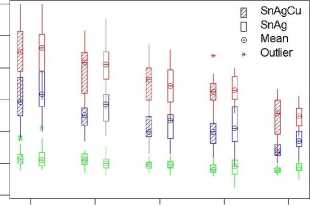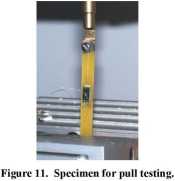7884079558
NPL Report MATC(A) 164
A cycle
|
temp | |
|
120 | |
|
z | |
|
sz |
100 |
|
O) c o |
80 |
|
00 | |
|
ro (U JZ (/) |
60 |
|
O) ro E |
40 |
|
3 |
20 |
|
0 | |

R1206
R0805
R0603
0 300 600 900 1200
Number of cycles
Figurę 10. Shear testing results for 3 sizes of chip resistor.
6.2. Puli Test
In the puli test (see Figures 11-13) a constant force of 100N was applied over 20 sec at a ratę of 3.3 N/sec and held for 60 sec (Figurę 14). The deformation was measured using a strain gauge (Figurę 12) mounted on the top of a resistor. Figurę 13 illustrates the primary deformation modę of the resistor-substrate system, as calculated using the FEA software tool PHYSICA [5],

9
Wyszukiwarka
Podobne podstrony:
NPL Report MATC(A) 164 Finał polishing of the samples was carried out by hand using a gamma aluminid
NPL Report MATC(A) 164 Figurę 5. Central scctioning point shows the microstructurc, but not dcvclopi
NPL Report MATC(A) 164 Cracked area Figurę 6. Crack in a SnAgCu soldcr joint after thcrmal cycling.
NPL Report MATC(A) 164 6. Mechanical Tests Mechanical tests were used to investigate the time-depend
NPL Report MATC(A) 164 The following steps were carried out: • The substratc was c
NPL Report MATC(A) 164 Figurę 12. Test arrangements of resistor specimen. Figurę 13. Predicted major
NPL Report MATC(A) 164 0
NPL Report MATC(A) 164 6.3. 3-Point Bend Test In the 3-point bend test the force was applied to the
NPL Report MATC(A) 164 regime used, the solder becomes accommodating and. irreversible plastic defor
NPL Report MATC(A) 164 curves coincide for displacements less than ~125 pm. For higher levels of dis
NPL Report MATC(A) 164Crack Detection Methods for Lead-free Solder Joints Milos Duśek and Christophe
NPL Report MATC(A) 1641. Introduction In electronics assemblies components and substrates are mechan
NPL Report MATC(A) 164 simulate this “worst case” scenario, 2512-type chip resistors and FR4 substra
NPL Report MATC(A) 164 Table 1: Tested temperaturę cycling regimes within ± 4°C of the set
więcej podobnych podstron